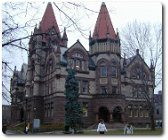The Handmaid's Tale Contents
Childhood and education
Parents and siblings
Margaret Eleanor Atwood (who was known for many years as Peggy) was born in Ottawa, Canada, on 18th November 1939 to Margaret (née Killam) and Carl Atwood; she had an elder brother, Harold (born 1937) and a much younger sister Ruth (born 1951). Her mother was a nutritionist and dietician, and her father was an entomologist, whose researches in Canadian forests meant that the Atwood family moved north into the backwoods every summer. This experience of the Canadian natural environment was to have a profound effect on Margaret.
Early education
 The family moved to Toronto in 1946, when Carl Atwood took up a position at the University. However, because of the annual stay in the woods, Atwood did not go to school full-time until she was eleven, attending Leaside High School. She graduated from there in 1957, before attending Victoria College at the University of Toronto, where she was taught by the eminent Professor Northrop Frye.
The family moved to Toronto in 1946, when Carl Atwood took up a position at the University. However, because of the annual stay in the woods, Atwood did not go to school full-time until she was eleven, attending Leaside High School. She graduated from there in 1957, before attending Victoria College at the University of Toronto, where she was taught by the eminent Professor Northrop Frye.
Beginnings as a writer
Having decided at the age of 16 that she wanted to be a writer, Atwood was writing throughout her time at University and began to read her poetry in public at a coffee-house called ‘The Bohemia Embassy’. Her first anthology of poems, Double Persephone, was printed privately and won the E.J. Pratt medal for poetry (awarded by Toronto University) in 1961.
Graduate studies: 1961-3
In 1961 Atwood left Toronto to attend Radcliffe College in Cambridge, Massachusetts, which later became part of Harvard University. She used this as the setting for the city in Gilead where Offred lives in The Handmaid’s Tale. Atwood found its atmosphere uncongenial and was very aware that Harvard employed no female teaching staff. She took a course on the Classical Tradition in American Literature run by Perry Miller, to whom she dedicated The Handmaid’s Tale.
Recently Viewed
Scan and go

Scan on your mobile for direct link.